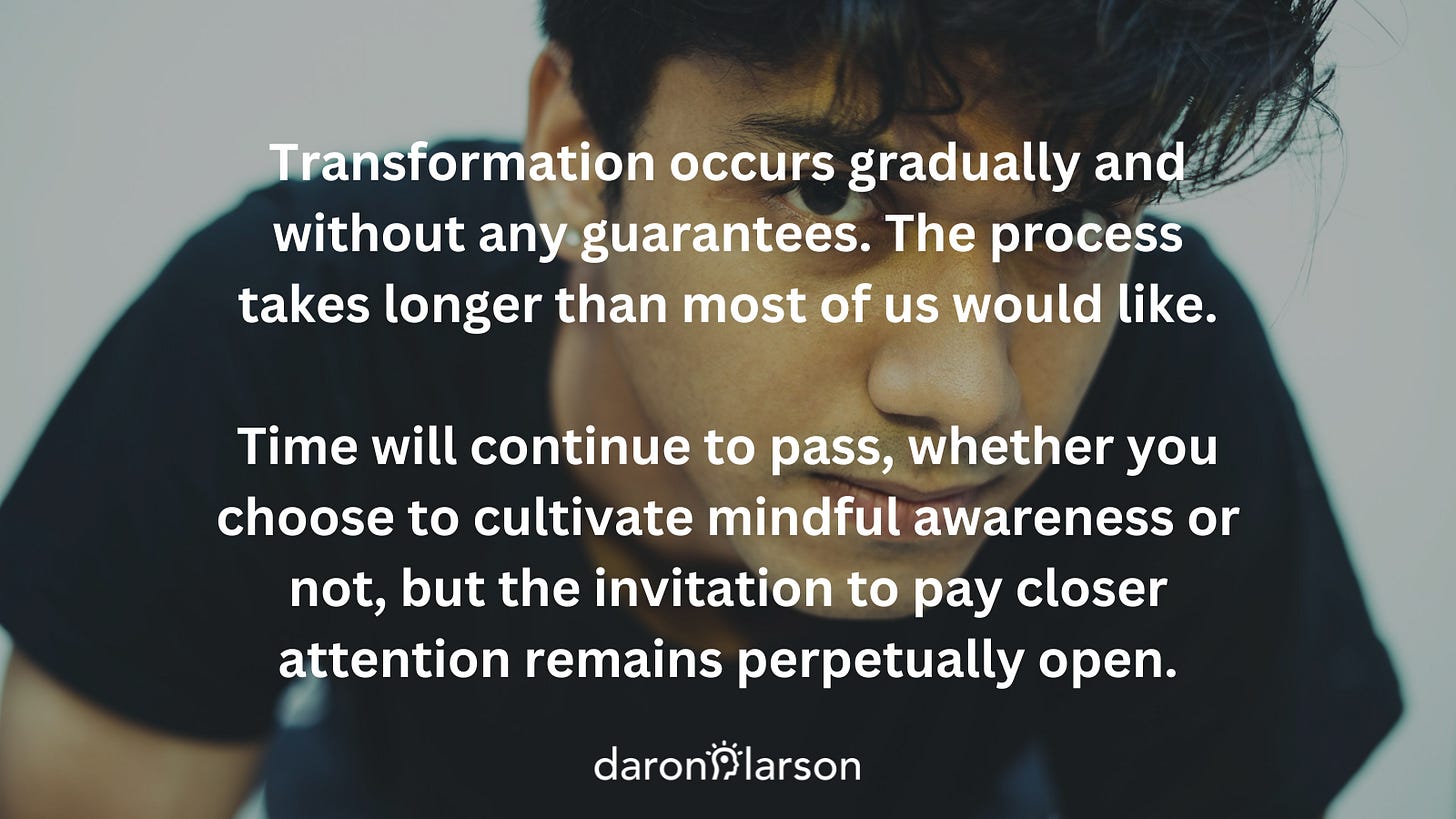There are understandable reasons to give up on mindfulness, valid reasons to stick with it, and a few things you can try before making up your mind.
Anyone who tries to practice mindfulness encounters several common annoyances.
You attempt to relax but struggle to stay awake.
When you try to clear your mind, thoughts keep flooding in.
While you aspire to be present, you often find yourself trapped in memories and worries.
You’re unable to fit 10-20 minutes of breath awareness into your daily routine.
You try to calm down when you’re upset, but often end up feeling worse.
Practicing mindfulness is intended to reduce internal friction, not increase it. Unfortunately, these obstacles convince many people that it’s beyond their abilities.
The underlying challenge is pretty similar to the struggle of exercising regularly. In the short term, it’s easier to avoid challenging your body than to deal with the discomfort and inconvenience that comes with strengthening it. However, consistently exercising—even when it feels uncomfortable—eventually leads to better physical health.
Practicing mindfulness can teach us to adjust our expectations about how attention works and help us develop a more hospitable relationship with our thoughts and feelings.
It turns out that some of life's most liberating lessons can be surprisingly uncomfortable to learn.
Reasons to persist
Mindfulness practice enhances your ability to focus and can make you feel more engaged in whatever you're doing. It involves noticing what’s happening within and around you and feeling more alive, even in less-than-ideal circumstances.
This can include:
Improving your ability to decide what to pay attention to and what to ignore.
Appreciating the richness of everyday sights, sounds, smells, flavors, and sensations.
Observing your thoughts with a little more distance.
Feeling your emotions more vividly and reducing the tendency to escalate the unpleasant ones.
Most importantly, they assist you in making peace with the messy complexity of humanity—both your own and that of others.
This process takes longer than most of us would like. Who can say how long it will take? Months? Years? Decades? The rest of your life? Or perhaps it will happen sooner than you expect? It often seems like a vague amount of time just beyond your willingness to wait.
Personal transformation occurs gradually and without any guarantees.
Experiments to help you decide
I understand not wanting to practice mindfulness.
Before you give up on it, though, try to approach it as a game rather than a test.
Here are a few ideas to try:
Pay attention to your breathing without trying to clear your mind.
Break your practice sessions into shorter segments.
Explore sensations related to bodily functions other than breathing, even the less obvious ones.
Practice with your eyes open.
Listen to the sound of your verbal thoughts.
Notice your emotional reactions throughout the day, as well as when you’re watching a series or movie.
Focus on sensory details while taking a walk.
Use mindful awareness to support other healthy habits.
Thoughts and feelings are essential parts of being alive. So are discomfort and uncertainty.
It’s simple but not easy to change how you inhabit your life.
Time will continue to pass, whether you choose to cultivate mindful awareness or not, but the invitation to pay closer attention remains perpetually open.
Exercise
This exercise sharpens your ability to recognize subtle, pleasant sensations that are quietly waiting to be savored within the breathing cycle.1
Circumstances for learning this attention exercise
Waiting for your coffee to brew
Standing in line
Sitting in your car
Settle in. Allow yourself as much time as needed to transition from your previous activities. Check your posture to ensure you’re feeling stable and supported.
Take a moment to notice the variety of sensations in your body, including what feels comfortable, uncomfortable, still, moving, purely physical, and clearly emotional. Listen to the mix of sounds and silence around you.
Try to gently hold the various contrasting perceptions in your awareness.
Focus on any relaxing sensations as you breathe out. To detect subtle sensations of relaxation, take a moment to pause for a few seconds before exhaling. As you exhale, focus on the pleasant sensations that arise. It’s perfectly fine to exhale a little more slowly than usual to truly enjoy these sensations and allow them to spread throughout your body.
When thoughts come to mind, rather than trying to push them away, consider lingering for a moment at the end of your next inhale. This can help you experience the mild discomfort of holding your breath before enjoying the relief of exhaling.
Focus on any pleasant sensations as you breathe in. Take a moment to focus on the experience of inhaling. Notice the beginning, middle, and end of each breath. There’s a subtle quality to how oxygen makes your body feel good that is often overlooked. Get curious about recognizing it.
If your mind starts to wander, just pause for a second before your next breath to acknowledge any mild discomfort, and then use the contrast to sharpen the enjoyable sensations of your body satisfying its subtle hunger for oxygen with fresh, delicious air.
Decide what to focus on. During the remaining practice time, you can concentrate on either breathing out, breathing in, or both. Choose the option that resonates with you the most. If you prefer, you can focus on inhaling, exhaling, listening to sounds, practicing gratitude, or cultivating loving-kindness.
Making mindfulness personal makes it more enjoyable and sustainable. It's also a powerful way to cultivate attentional agency, which is the freedom to decide what to focus on at any given moment.
"Standing Invitation" by James A. Pearson Come home to this body. It's living your life.

I learned this exercise from Shinzen Young, and it’s included in his book, Natural Pain Relief: How to Soothe and Dissolve Physical Pain with Mindfulness.














